The building is a lofty, well-ventilated one of hardwood frame, with galvanized-iron walls and roof, and consists of five spans running north and south, covering a total length of 230 ft. Each span is composed of nine bays of 13-ft. centres, making the total width of the building 117 ft. The refinery is situated conveniently at a distance of 100 yds. from the smelters.
Through the third span of the building runs a 5-ton electric overhead travelling crane, of a 3-motor type, with a span of 29 ft. The crane runway extends over a railway line, which connects the smelters to the refinery. This crane is used for handling bullion, coal, melting kettles, lead pumps, &c.
A 3-ton crane of similar type, but with a 50-ft. span, rims through the fifth span of the building, and also extends over the railway line already mentioned. This crane is used to load the soft lead into railway trucks, or to stack lead awaiting shipment in the area covered by the crane’s operations.
The installation is in two units in parallel, each unit consisting of :—
One 50-ton Copper-drossing kettle.
One 46-ton Antimony softener.
Two 44-ton Desilverizing pans.
One 40-ton Refiner.
One 38-ton Market kettle.
One Moulding ring.
Common to both sets :—
One small furnace for working up skimming s and drosses.
One Antimony dross furnace.
One Gas producer for retort furnace.
One four-bottle regenerative gas-fired retort furnace.
Two single-bottle oil-fired tilting retort furnaces.
Three concentrating cupels.
Two finishing cupels.
Electrolytic parting plant.
Gold and silver melting furnaces.
The 44-ton desilverizing kettles and 38-ton market kettles are handled on special runways, centred over their respective kettle settings. These runways are carried on two 14-in. x 7-in. Oregon beams supported on C.I. brackets and, spiked to these 14-in. x 7-in. beams, are the rails which carry a ball-bearing crawl. To this crawl is suspended a tackle, from which are hung slings to lift the kettles. The travelling of these is done by hand, but is easily operated by one man. Ordinarily, these crawls are used to hang and travel the Howard presses and stirrers.
There are three working-floor levels in this building : No. 1, on the dump level, known as the cupel refiner parting room and firing-floor level; No. 2, on a level 3 ft. 6 in. lower than this, known as the moulding and soft lead storage floor ; and the other, No. 3 floor, being elevated 7 ft. above the No. 1 or refiner floor. This elevated floor is known as the top floor, and is the one from which the melting kettles, softeners, desilverizing kettles, &c., are worked. This floor is built in reinforced concrete, with indented bar reinforcement. It is designed to carry 12½ cwt. per super, ft., having

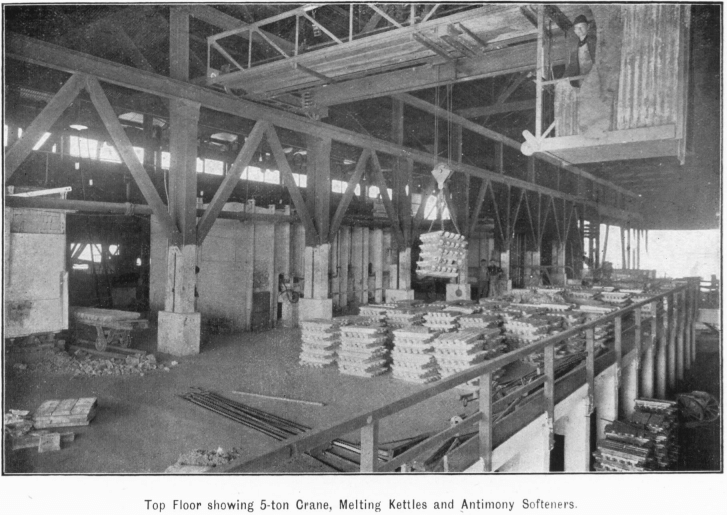
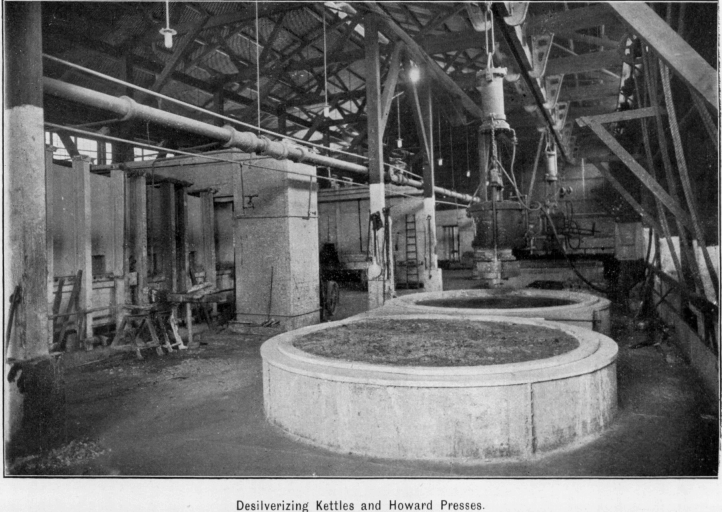
12-in. x 12-in. columns on 3-ft. 6-in. sq. footings. The beams are 24 in. x 12 in. up to 27 in. x 15 in., according to span. The floor proper has a total thickness of 9 in., 8 in. of this being 4-2-1 mixture, the other inch being a specially finished floating coat, laid while the main body was still plastic.
The advantage of the elevated floor is, that it allows a more perfect ventilation for the men engaged working on the No. 1 floor level, and also provides storage space for the various material used in connection with the operations. It also allows easy access from one end of the building to the other.
The various furnaces are connected to three stacks of similar construction through the three main parallel flues running underground.
The base bullion, after being drossed and moulded (25 bars per ton) at the smelters, is run on trucks via a low-level railway, direct to No. 1 electric crane, slung and hoisted in two-ton lots to the copper-drossing kettles. The bars are charged into the kettle, melted at a low temperature, and the copper dross skimmed. This dross is treated in a small liquating furnace, and the liquated bullion returned to the refinery, the copper dross going to the smelters. The molten metal in the copper-drossing kettle is then transferred to the antimony softener by means of a direct-coupled electrically-driven Rumsey centrifugal pump. These pumps are an innovation in Australian refinery practice. The pump is permanently fixed in a frame, which rests on the circumference of the kettle, and so arranged that, when in position, the pump is immersed to the full depth of the kettle (the casing is provided with spacing studs to keep it from actually resting on the bottom).
The time of pumping 40 tons is twenty minutes.
The antimony softener is the usual reverberatory type, water-jacketed, and lined with magnesite bricks at the litharge level; the end jacket is centrally channelled, the channel leading into a removable inclined spout, carrying the litharge into portable slag pots. After charging, the furnace is strongly fired, giving an oxidizing atmosphere, the resultant litharge being constantly run off at the channel and acting as a vehicle for carrying off the antimony and arsenic.
Towards the end of the operation the furnace is allowed to cool back, and the crust of litharge is skimmed by hand. The further treatment of the antimony and arsenic dross will be referred to later.
The operation takes, according to the antimony and arsenic contents, from eight to twelve hours, from time of charging to time of discharging into the desilverizing pans.
When “ clean ” the metal is tapped into one of two desilverizing pans, and the gold and silver separated by the Parkes process. No attempt is made to separate the gold and silver in the crusts, the whole alloy being mixed and retorted. The gold and silver contents are very variable,’ but only two zincings are made.
The spelter is added in cakes, melted on the surface and stirred in mechanically by means of the Howard rope-driven stirrer. The first zinc alloy is pressed off by the Howard press, which is worked by pneumatic pressure, and conveniently handled by an air hoist supported by a carriage on overhead runway. The second zincing is skimmed by hand. The pressed alloy goes direct to the retorts.
The desilverized lead is then syphoned to the refiner (usual reverberatory jacketed type) on the lower floor, and the zinc and any remaining antimony removed as a dross by skimming. The refined lead then passes by gravity to the market kettle, from which it is syphoned into a pot and runner, and moulded in a semicircular rake of hundredweight moulds, further skimmed and trimmed, weighed, stacked by means of a three-ton electric crane, and is then ready for shipment.
The shimmings from the antimony softener are stacked, and treated periodically in the antimony dross furnace ; a furnace with refractory lining, but no water-jackets. The material is charged in 3000-lb. lots, mixed with sufficient fine coal to reduce the bulk of the metal, the antimony and arsenic remaining in the slag. The slag and metal are periodically run off, the former into a bed, the latter into a five-ton kettle, from which it is moulded into bars and returned to the copper-drossing kettles. The slag, when cold, is broken up and further treated in a small blast furnace, the metal carrying the antimony and a trace of arsenic. This antimonial lead is finely melted in a kettle and
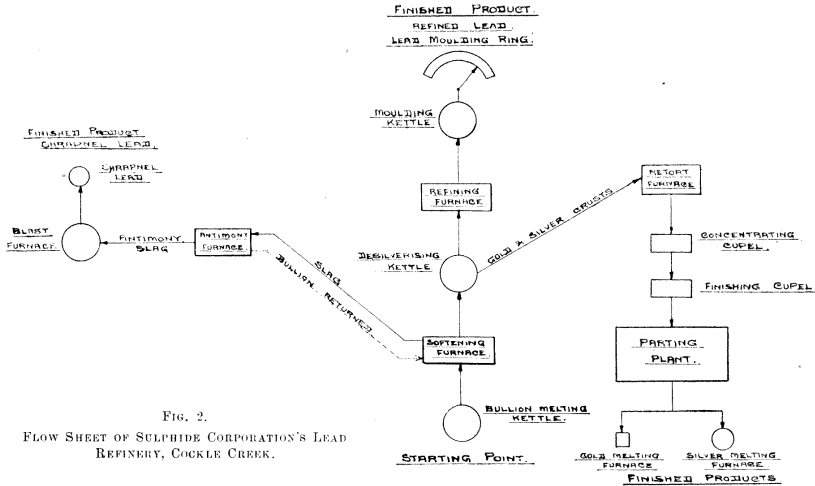
the antimony percentage reduced by dilution with refined lead to the requisite quantity for marketable shrapnel lead, and moulded into dumpy hundredweight bars.
Returning to the pressed silver-zinc alloy from the desilverizing kettles, we find that this is charged in 12-cwt. lots to the inclined bottles of the gas-fired retort furnace, the zinc distilled and condensed, and the retorted bullion ladled into moulds.
The two tilting retort furnaces are a special feature of the plant, and are worked by one attendant. Each furnace is supplied with a low-pressure burner using oil from the Mond gas plant. This oil, which is also used in the gold and silver melting furnaces, is a heavy distillate from the tar, and has proved very efficient. The amount of oil used is 26 gal. per shift of eight hours. One charge of 10-cwt. alloy is finished each shift. The retorted bullion from the tilting furnace is lower in zinc than that from the gas-fired retorts. The life of the retorts in the tilting furnaces is very good, and for simplicity of operation the furnaces are a great success. When ready, the molten metal, instead of being ladled as in the case of the ordinary retort, is poured by tilting the furnace direct into moulds placed at the requisite height on a stepped portable frame. The retorted bullion (assaying 2000 to 2500 oz. Ag per ton) passes to the concentrating cupels, where it is worked up to “ concentrated bullion,” the lead passing off as litharge, which is granulated in water, the final alloy containing approximately 16,000 oz. silver and gold per ton. The charge held by the cupel or “ test ” increases with use from 10 cwt. to 14 cwt. The concentrated metal is ladled into moulds and transferred to the “ finishing cupel.” Here it is worked up to Dore, which may undergo a further transference to a “ drying cupel,” that removes the last traces of lead by absorption. The pure Dore is then ready for moulding for the parting operation into anodes; these are rectangular plates about ¼-in. thick, weighing approximately 100 oz.
The electrolytic parting plant is furnished with 36 earthenware cells of the Balbach type. Each cell contains two wooden paraffined cradles with inner frames, holding the cloths (10-oz.
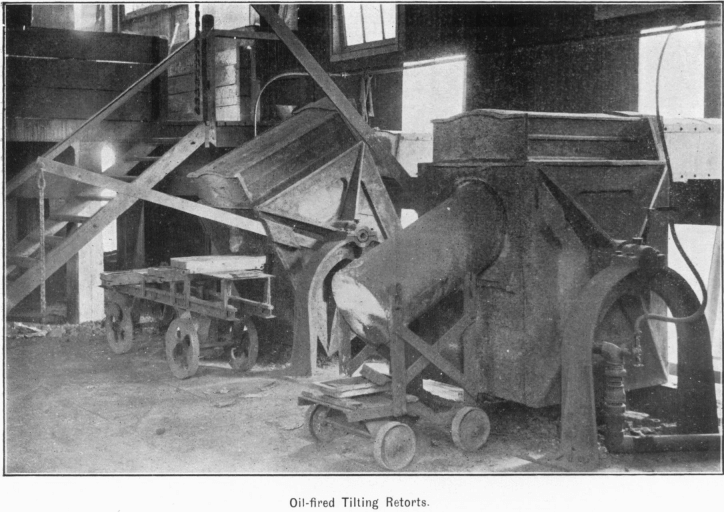
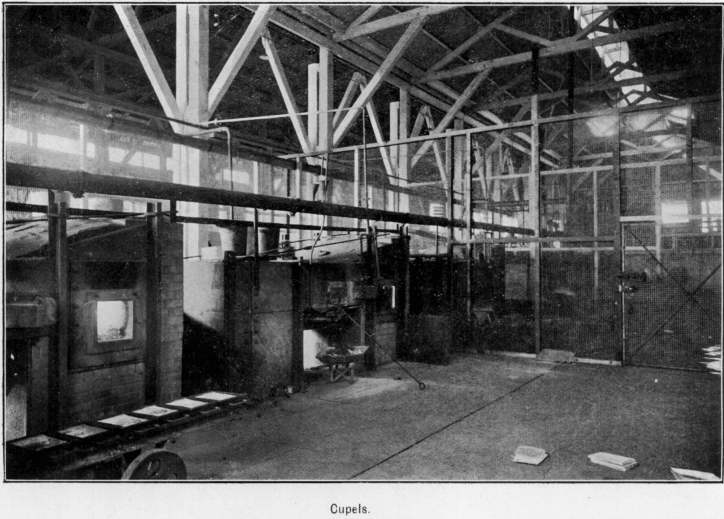
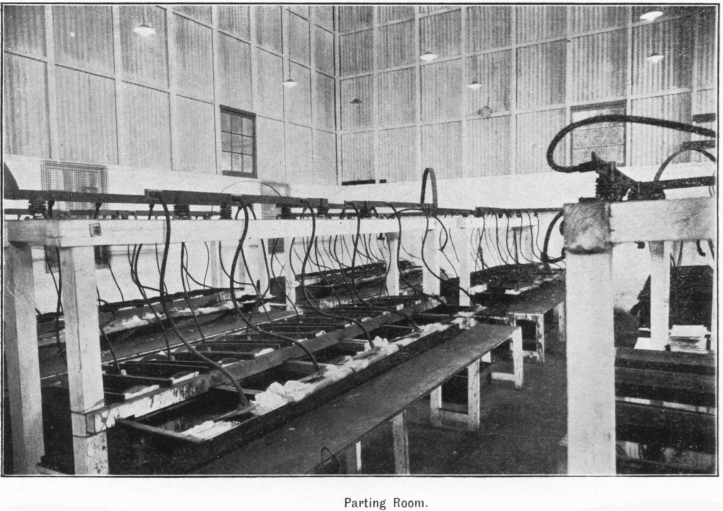
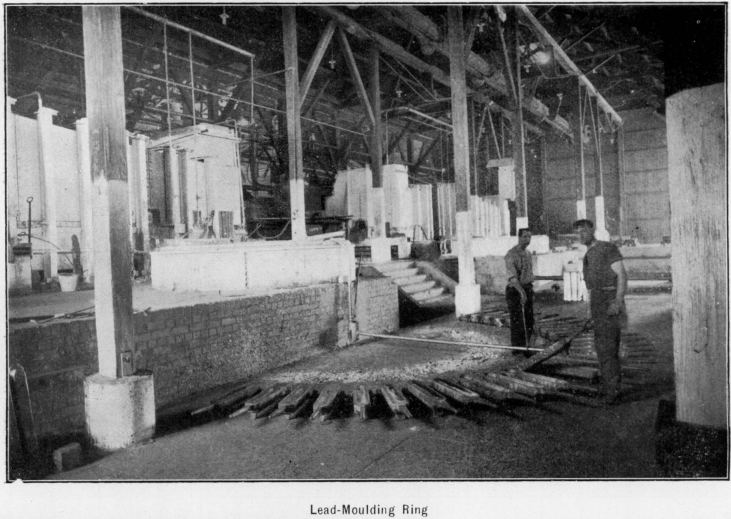
linen duck). The anodes lie horizontally on the cloth, and are just immersed in the electrolyte. The electrolyte is essentially a solution of silver nitrate carrying as impurities a small quantity of lead nitrate and a considerable amount of copper nitrate. The solution is slightly acid, usually about 3 grm. per litre of free nitric. The current is passed to the anode by means of a “contact” piece (usually of pure Ag), and the silver deposited as pure crystalline metal on the carbon cathodes, which lie on the bottom of the cell. The silver is raked forward periodically and drained on the lip of the cell, withdrawn, washed in a separate wooden vessel, and stored loose in draining boxes. When comparatively dry it is bagged in very light calico bags, charged to a Morgan tilting furnace, and run into bars of 1050 oz. The gold remains as a sludge on the cloths. This is dried, inquarted with three times its weight of silver, and re-parted to give a denser product. Any remaining silver is dissolved by boiling with concentrated sulphuric acid, the gold washed free of silver, and melted in a Rockwell oil-fired furnace into bars of about 600 oz. The silver is remarkably pure, assaying 999.9 fine, and carrying only traces to 4 dwt. of gold per ton.
All kettles and furnaces, with the exception of the retorts, are fired direct with coal, but later on, no doubt, these will be heated by means of Mond gas. At present, however, the supply is not available, and it is impossible to build further producers until the supply of steel plates becomes more plentiful.

